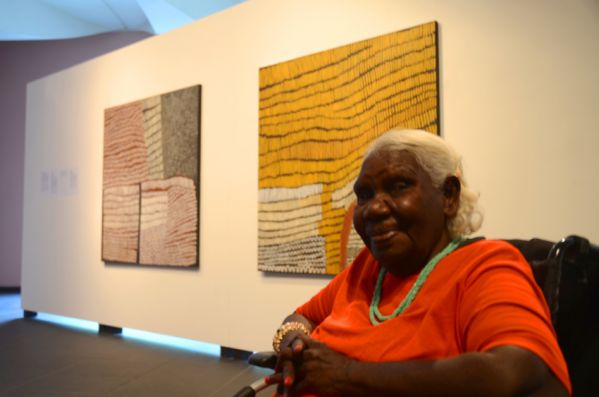
Image: Artist Lena Nyadbi at the exhibition Gija Manambarram Jimerawoon
© Jonathan Kimberley – Warmun Art Centre, 2013
“The soul of your people navigates from the immensity of the Kimberley to the density of Paris,” H.E. Mr Stéphane Romatet, Ambassador of France to Australia, insightfully declared during the inauguration ceremony of the monumental installation Dayiwul Lirlmim by Gija artist Lena Nyadbi in Paris on 6th June 2013.
The enlarged, stenciled reproduction of Lena’s extraordinary black and white artwork, 46 times bigger than its original painted version, constitutes the “last punctuation” imprinted on the museum building, in the words of President of the musée du quai Branly Stéphane Martin. Indeed, the public commission that the institution launched in 2006 permanently integrated Aboriginal Art within its very architectural structure. In so doing, it addressed an invitation to the uninitiated Western audiences to discover a millenary representational tradition from the other side of the globe, enabling the double possibility of an aesthetic encounter through contemplation, and of one’s active involvement in the knowledge and understanding of the Dreaming. Committed to this reciprocal opening of cultures as well as to the circulation of their signs, Lena Nyadbi then contributed to spreading Aboriginal art by tattooing the façade of the rue de l’Université with Jimbirla (spearhead) and Gemerre (scarification) motifs, which belonged to the traditional heritage of her father’s country.
This time, seven years after her first contribution, Lena depicted another legendary story of the Gija Country to ornate the roof terrace of the Musée du quai Branly: that of the Barramundi Scales which shaped her home land in the Dreamtime. According to the legend, three women were fishing for barramundi when one fish eluded the net and escaped through a gap in the rock. It shed its scales in the process, which over time became glittering diamonds. The traditional story of the Dayiwul Lirlmim is intrinsically attached to the area now known as Lissadell Station, which is home to the largest diamond mine in the world.
The unveiling of Lena Nyadbi’s exquisite work on the “fifth façade” of the Musée du quai Branly furthers the original dynamics along which Jean Nouvel, the architect of the museum, deliberately conceived the building. For the Musée du quai Branly was not intended to strictly serve as a shelter for artworks. It was designed to lead a life of its own, to become a powerful signifier and conveyer of meaning itself, through the works of Aboriginal artists. The enthusiastic response of the French audience who attended the inaugural ceremony, watched the film “Rooftop” (about the creation of Lena Nyadbi’s installation) with great emotion and delight, and warmly acclaimed the artist in a packed theatre of the Musée du quai Branly, testifies to the success of the project. Dayiwul Lirlmim “simultaneously affirms specific cultural meaning […] and its universal beauty”, Lee-Anne Buckskin, Chair of Aboriginal and Torres Strait Islander Arts Board, rightly said. The Western world’s growing attraction for Aboriginal Art shows the powerful resonances of the representations of the Dreaming in the contemporaneous realities of the Western world, and the importance of placing these representations at the heart of intercultural dialogue.
By telling the legendary story of the Barramundi Scales to the millions of visitors who climb up the Eiffel Tower every day, Lena enabled the mythical ancestor to travel all the way to Paris – possibly by swimming up the river Seine which runs just by the museum – and to carry on its journey with the international visitors of the Parisian emblematic monument as they bring it back to their home countries.
“Well, Barramundi is everywhere,” the artist concluded in the “Rooftop” film. And in fact, the barramundi does fill the French capital with its presence: at the Musée du quai Branly, but also at the Australian Embassy in Paris. The exhibition Gija Manambarram Jimerrawoon (Gija Senior Law People Forever), currently [1] held at the Embassy in response to the unveiling of Lena’s installation, presents the works by eight leading contemporary Gija artists from Warmun Art Centre. Strikingly enough, the scenographic arrangement of the show is reminiscent of the Barramundi’s scales: the layout is structured around regularly spaced out curved wall panels, where the artworks are hung and which remind one of the scales the Barramundi shed in its mythical flight. Let us then extend H.E. Stéphane Romatet’s metaphor and hope that Lena’s work will keep navigating, in Paris and around the world.
Bénédicte Vachon
Reference:
[1] Gija Manambarram Jimerrawoon (Gija Senior Law People Forever). Australian Embassy in Paris – 7 June-30 October 2013. A Warmun Arts Centre Exhibition, supported by the Harold Mitchell Foundation and the Australia Council for the Arts.
About the Author:
Bénédicte Vachon, IDAIA’s Representative and Curator in France.